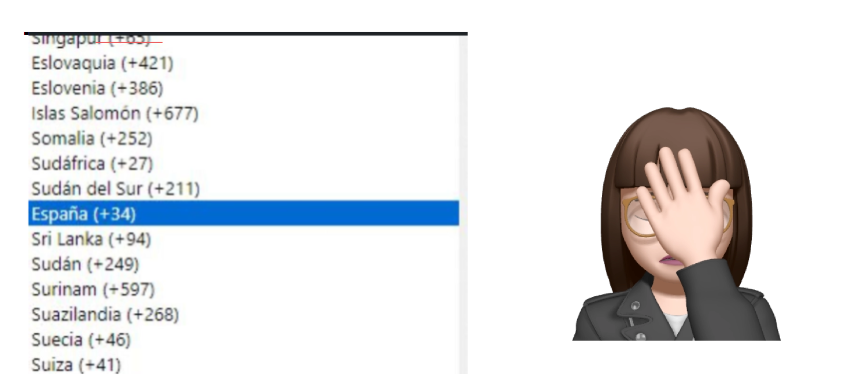When we dive into International SEO, one topic dominates 90% of the discussions, articles, and even SEO talks: hreflang tags. And yes, they're a complex beast. Even John Mueller from Google once tweeted, "TBH hreflang is one of the most complex aspects of SEO (if not the most complex one). Feels as easy as a meta-tag, but it gets really hard quickly."
But are hreflang tags the whole story? Absolutely not! In fact, when you enter new markets and the only action you take is implementing hreflang tags, this is what can happen:

I regularly encounter this challenge with businesses that operate websites in different countries sharing a language, such as Germany and Switzerland, Spain and Mexico, or Portugal and Brazil. They replicate the exact same content and fail to adapt it to the cultural and contextual specifics of each market. The consequence? Google might not index one of the versions, opting to show the version for the other country instead.
This issue sometimes arises inadvertently when businesses engage translation agencies that falsely promise services like "International Spanish" will be effective across diverse markets, without taking into account localization—our focus in today's article and a game-changer for those looking to go international.
What is a bad translation?
Before diving into what is localization, you may be wondering what is a bad translation. Perhaps in your mind, you're envisioning something like this:
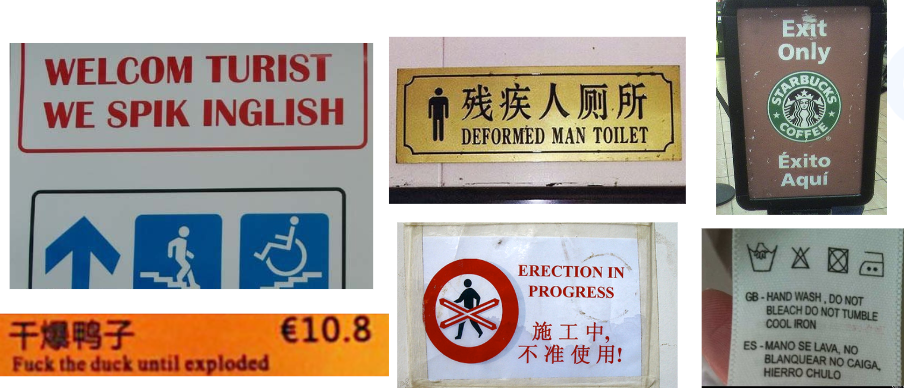
And yes, those are awful! But the truth is, bad translations certainly go beyond grammar errors and the most obvious mistakes. Here's how to detect a bad translation:
- Fails to convey the meaning of the original text accurately.
- Contains errors in grammar, spelling, or punctuation in the target language.
- Uses inappropriate or outdated terminology.
- Sounds unnatural or awkward in the target language.
- Changes the tone or style of the original.
What is localization?
We could define localization as the process of adapting a piece of content's full meaning for a new region, including translation, associated imagery, and cultural elements that influence how your content will be perceived. So yes, it goes beyond mere translation, and it's way more powerful.
Let me illustrate it with a potato. You may be familiar with the word "Kartoffel", which means "potato" in German. But did you know that it is only called that in Germany? In Austria it is known as "Erdapfel", and in Switzerland "Herdöpfel".
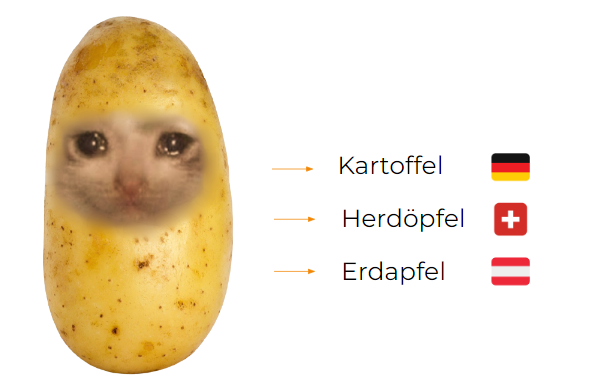
The same goes for a character you're likely familiar with from your childhood, Mickey Mouse. In Italy, he's known as Topolino; in Sweden, Musse Pigg; in Poland, Myszka Miki; in Finland, Mikki Hiiri; in Germany, Micky Maus; and he even has a Latin name for any readers in Vatican City or lovers of the language that gave birth to so many others — Michael Musculus!

Another example that might clarify this concept involves English terminology differences: "trainers" in British English versus "sneakers" in American English, and "jumper" or "pullover" in British English as opposed to "sweater" in American English.
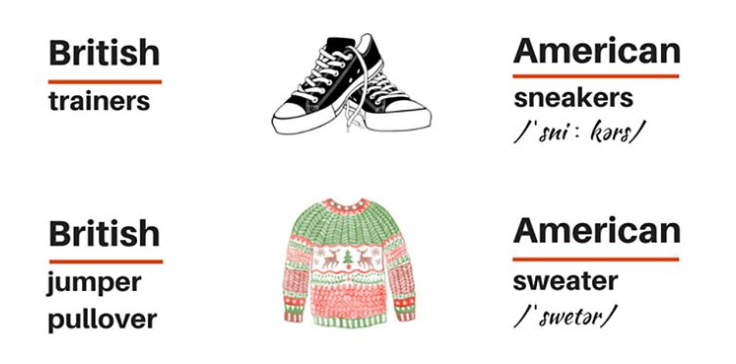
Similarly, in Spanish, the word for "computer" is "ordenador" in Spain and "computadora" in Mexico. Because of these variations, if you truly want to resonate with each target audience (and achieve much better conversions), it's crucial to optimize content by country, not just by language. Also, avoid mixing different variations, as it won't sound natural.
What can be localized?
To better understand localization and its impact, let's examine what we, as SEOs, marketers, translators, and anyone involved in international operations and expansions, can localize.
Brands
Let's consider Algida-Frigo, or whatever it's called in your country. It's one of those brands that frequently changes its name depending on the market it serves. This isn't just about translating the name, but choosing a completely different one that resonates more effectively with the local audience.
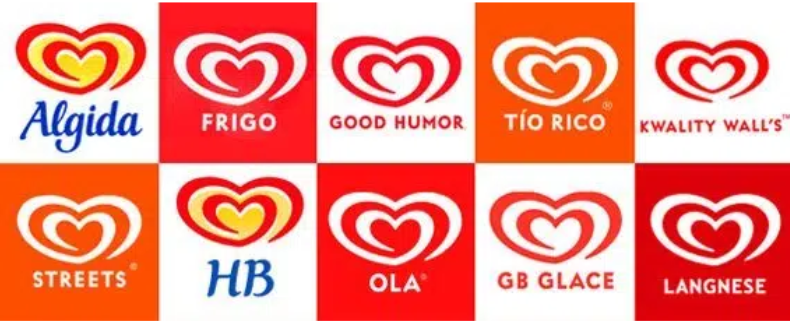
Another example that I love is "Coccolino," which I used to encounter in Italian supermarkets back when I was living in Milan. In Spain, this fabric softener brand is called "Mimosín." Derived from "coccole" and "mimos," respectively, both mean "cuddles." The brand's aim is to evoke feelings of softness, care, and comfort, aligning with the product's promise to make fabrics feel cozy and gently scented.

Such changes are meticulously strategized to ensure the brand maintains its appeal and recognition, irrespective of geographical and cultural differences. Localization of brand names demonstrates a deep understanding of the local market's language nuances, cultural sensitivities, and consumer behavior. It goes beyond simple translation to forge a stronger, more meaningful connection with the target audience, showing that the brand is not just present but also attuned to and respectful of local customs and preferences.
Key reasons why brands are localized
- Acquisitions: Retaining well-established local brands to preserve customer loyalty. When a brand acquires a company in a new market, it may choose to retain the acquired company's brand name to maintain the existing customer base and brand loyalty. This approach helps to avoid alienating customers who are already familiar with and loyal to the acquired brand.
- Cultural fit: Adapting names for linguistic ease and cultural relevance. Localization involves tailoring brand names to better resonate with the language and culture of the target market. This can include modifying the pronunciation, spelling, or meaning of the brand name to ensure it is easily understood and culturally appropriate for consumers in the new market.
- Market strategy: Tailoring brand positioning to local tastes and competitive landscapes. Brands often adjust their positioning and messaging to align with the preferences and expectations of consumers in different markets. This may involve highlighting different product features or benefits, emphasizing different brand values, or adopting a different marketing approach to better appeal to local consumers and differentiate from competitors.
- Legal compliance: Navigating trademark issues with region-specific brand names. Localization may also be driven by legal considerations, such as trademark regulations and intellectual property laws. In some cases, a brand may need to modify its name to avoid infringing on existing trademarks or to comply with local regulations regarding brand names and logos.
Example: Brand localization for Vicks VapoRub
Let's delve into a real-world example of brand localization that illustrates these key reasons. Consider Vicks VapoRub, a popular cough medicine brand. When Vicks sought to enter the German market, they encountered a unique challenge related to pronunciation differences. In German, the letter "V" is pronounced as "F," which meant that "Vicks" sounded like the English F-word, leading to potential misinterpretation and negative associations. Even the attempted alternative "Wicks" faced issues due to its similarity to a German slang word with sexual connotations.

To address this challenge, the brand underwent a strategic renaming process, transitioning from "Vicks VapoRub" to "Wick" VapoRub for German-speaking markets. This decision aimed to mitigate pronunciation issues and cultural sensitivities while maintaining brand recognition and appeal. However, this example also highlights the importance of thorough market research and cultural awareness in the localization process to avoid potential risks and ensure successful market entry.
Example: Brand localization for Axe and Lynx
The brand Axe, introduced in France in 1983 by Unilever, faced a unique challenge as it expanded internationally. Although Unilever intended to market its range of grooming products under the same name globally, trademark conflicts prevented the use of the name "Axe" in certain countries. Consequently, in the United Kingdom, Ireland, Australia, and New Zealand, Unilever had to adopt an alternative name for the brand: "Lynx." This change was necessary to navigate the legal landscape and respect existing trademark registrations in these regions. Despite the difference in name, the products marketed as Lynx in these countries are essentially the same as those sold under the Axe brand in other parts of the world. This adaptation is a clear example of brand localization, where a company modifies elements of its brand, such as its name, to suit local markets while maintaining the core identity and offerings of the brand.

Promotions
Not every country follows the same retail calendar. For example, while the West gears up for Black Friday, China celebrates Singles' Day (11:11). This means we must create tailored promotions that resonate with the local audience's cultural and shopping traditions, ensuring they are relevant and compelling. It's crucial to have promotions calendars tailored to each market, aligning with their unique events and shopping seasons.

Festivities
Festivities like Mother's Day are observed on different dates around the world. For example, in Spain, Mother's Day falls on the first Sunday in May. In Italy and the US, however, it's celebrated on the second Sunday in May. Meanwhile, in the UK and Ireland, it is celebrated on the fourth Sunday of Lent, often occurring in March. But did you know? In Thailand, for example, Mother's Day coincides with the birthday of the current queen mother of Thailand, Queen Sirikit, on August 12th.
Tailoring your marketing strategy and promotions to align with local observances of global festivities ensures relevance and resonance with the target audience, demonstrating respect for cultural traditions, and enhancing brand perception.

Names and titles
Names and titles often undergo localization to ensure they resonate with the cultural context and sensitivities of different regions. For example, in Italy, the movie "Moana" by Disney was renamed "Vaiana" to avoid association with an Italian adult film star of the same name (Moana Pozzi), showcasing localization beyond language to respect cultural context. This tweak shows us that localization isn't just about words; it's about understanding the cultural landscape—and avoiding some unexpected search results!

Colors
Colors carry deep cultural, emotional, and religious significance across different societies. What's considered appealing in one culture might be controversial or misinterpreted in another. For instance, mourning customs vary significantly between Asian and Western cultures, with white symbolizing mourning in many Asian countries like China, while black is more commonly associated with mourning in the West. Additionally, green is revered in Islamic countries for its religious significance, representing Islam. Be ready to adapt your branding and marketing materials to reflect local color associations and avoid potential controversies.

Cultural references and sensitivity
Cultural references play a significant role in engaging local audiences, as they can deeply resonate with their cultural backgrounds. However, it's crucial to approach these references with cultural sensitivity. This means understanding and respecting the diverse cultural differences and nuances to avoid stereotypes or cultural appropriation. By doing so, content not only becomes more relatable and engaging but also demonstrates inclusivity and respect for various cultural perspectives.
Example for cultural references: 7-Eleven
In a text mentioning shopping at 7-Eleven, a convenience store chain familiar in many countries but not present or well-known in Spain, directly translating this reference for a Spanish audience without adaptation could lead to a lack of connection or context, as the brand doesn't hold the same relevance or recognition. The solution is to replace or adapt specific brand references with names that are locally recognized, such as Mercadona, or explain what it is by providing some context: "a well-known convenience store chain in the US, 7-Eleven..."

Example of an epic fail: Sundae Bloody Sundae
McDonald's "Sundae Bloody Sundae" promotion in Portugal, which was initially inspired by the song "Sunday Bloody Sunday" by U2, inadvertently sparked widespread controversy by evoking memories of a tragic event in Northern Ireland known as "Bloody Sunday." On January 30, 1972, British paratroopers shot and killed more than a dozen civil rights protesters in Derry, an event discussed in the song. Unaware of the song's connection to this historical incident, McDonald's launched the campaign, once again underscoring the critical need for cultural sensitivity when making a marketing strategy, as well as the importance of understanding cultural contexts and history of the messages we launch to avoid offending the public and damaging the reputation of the brand.

Cultural sensitivity: how to get it right
Here are some steps that will help you ensure that you're on top of cultural sensitivity:
- Research: Conduct thorough research into the cultural and historical background of the target audience. Understand their traditions, values, beliefs, and historical events that may impact their perceptions and preferences.
- Consult: Seek guidance from local experts, cultural consultants, or members of the target community. Their insights can provide valuable perspectives on cultural nuances, sensitivities, taboos, and appropriate messaging.
- Empathize: Approach marketing efforts with empathy and respect for the diverse backgrounds and perspectives of your audience. Put yourself in their shoes to better understand their needs, concerns, and aspirations.
- Iterate and validate: Continuously test and refine your marketing strategies with input from a diverse group of stakeholders. Solicit feedback from representatives of different cultural backgrounds to ensure that your messaging resonates positively and avoids unintended offense.
Practical localization
When localizing content for international audiences, attention to detail is key. Here are some practical considerations:
- Currencies: Reflect local currency accurately to build trust and clarity.
- Units of measurement: Adapt measurements to align with local norms, such as kilometers versus miles or Celsius versus Fahrenheit.
- Payment methods: Integrate preferred local payment options to streamline checkout processes.
- Formats: Localize formats to align with regional preferences. Depending on regional conventions, date formats may vary significantly. For instance, while many countries follow the DD/MM/YYYY format, in the United States, the MM/DD/YYYY format is standard. Moreover, in Hungary, individual days are typically expressed in the year-month-day format (YYYY/MM/DD), with numeric date elements commonly followed by a period. This underscores the importance of tailoring date and time representations to suit local norms, ensuring clarity and consistency in communication. Additionally, variations in the start of the week, such as beginning on Sunday instead of Monday in certain cultures, should also be considered when addressing global audiences.
- URLs: When dealing with Cyrillic, Arabic, or other non-Latin scripts, ensure that you transcribe them, use numbers, or keep them in English. There isn't a one-size-fits-all solution for this, but URLs currently must be written in Latin alphabet. Be sure to consult with local experts to determine the best approach for each market, as the solution may vary from country to country.
- Dropdowns: If Spanish is your native language, you've probably noticed that often country dropdowns maintain the same order, even if "Spain" is translated to "España". This means it should be included with countries that start with an "E", not an "S". Make sure to reorder dropdown options after translation to maintain alphabetical order in the new version.

Legal requirements
Adapt content to comply with local laws, regulations, and standards (e.g., GDPR in Europe). Otherwise, you may have to call Saul Goodman 😉

As you can see, localization goes beyond simple translation to adapt products, content, and marketing to fit the cultural, linguistic, regulatory, and market preferences of different regions. Ensuring compliance with legal requirements is essential for avoiding penalties, lawsuits, and reputational damage that can arise from non-compliance. Therefore, thorough research and consultation with legal experts are crucial steps in the localization process.
How to create a localization plan for SEO?
Now that we have explored what can be localized, let's create an action plan with these four key steps:
- Market analysis: Conduct a detailed examination of each target market, including cultural preferences, specific market demands, and consumer behavior.
- Competitive analysis: Compile a list of local competitors and analyze their market positioning, localization strategies, and keywords usage. Identify gaps for potential opportunities in the market.
- Language strategy: Develop a glossary of terms specific to the industry and product, tailored for each market. Create language style guides for each country (instead of per language, i.e., one for Spain and a separate one for Mexico, for example), outlining tone, formality level, and cultural nuances.
- Legal and regulatory compliance: Overview of legal requirements for each market (data protection laws, consumer rights, etc.). Guidelines for compliance with local regulations.
Do local keyword research
Local keyword research is indispensable for adapting your content to the linguistic and cultural nuances of regional audiences. For example, for an online knitwear retailer, the term “sweaters” resonates in the U.S., while “jumpers” is the go-to term in the U.K. Don't reuse keyword research conducted for the U.S. market in the U.K., even if the words don't change. Searches (both in terms of queries and search volumes) can vary because interests aren't necessarily the same across regions.
Use local idioms and metaphors
Local idioms and metaphors enrich content, making it more relatable and engaging for the target audience. They enhance keyword richness, aligning content more closely with the search queries native speakers are likely to use. Utilizing language that reflects local customs and speech patterns builds authenticity, fostering trust and a stronger connection with the audience. Employing unique local idioms sets your content apart from competitors, offering a tailored experience that global generic content cannot match.
Be mindful of technical localization requirements
Pay attention to specifications such as character sets, date formats, currencies, and measurement units. Additionally, remember to localize URLs, metadata, and schema markup. For example, consider including both mph and km/h in vehicle schema, depending on the region. Furthermore, plan for website and app localization, which may involve adapting UX/UI elements and providing support for right-to-left (RTL) languages if applicable
Examples of UX across cultures
To better illustrate how localization impacts from both a technical and layout perspective, I recommend watching the following videos about User Experience in China, Japan, and Arabic countries. I also encourage you to search for additional examples from other countries I haven't mentioned!
UX in China
UX in Japan
UX in Arabic countries
Use regionally relevant images and videos
Use images and multimedia that visually convey emotions vary from country to country — representation matters. When you are trying to sell to people from different countries with different cultures, it’s essential to use an image that resonates with them.
Here you can see examples of the Nike home page for Japan and the United Arab Emirates. As you can see, they're tailored to their specific audiences.
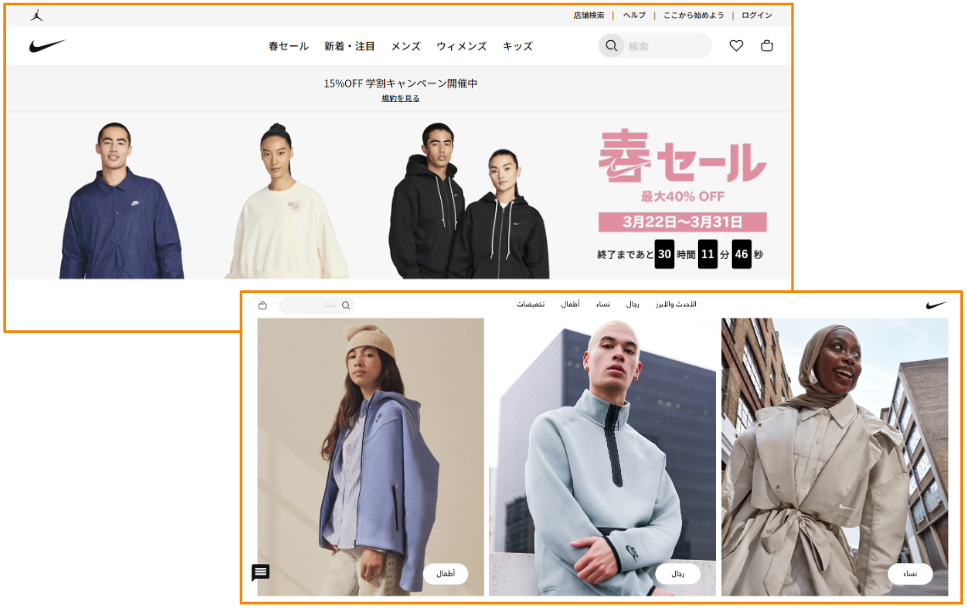
Always mind mental models
Mental models are cognitive frameworks or representations that individuals use to understand the world around them. They are shaped by personal experiences, cultural background, and societal influences. For instance, if I mention the word "house", your mental model might conjure an image of an apartment if you grew up in a city, or a house nestled in the woods if you have rural living experiences.
Always ensure that you adapt to those mental models, as I illustrated in an old rant on Twitter where I made a suggestion for Uber Eats via Twitter/X:
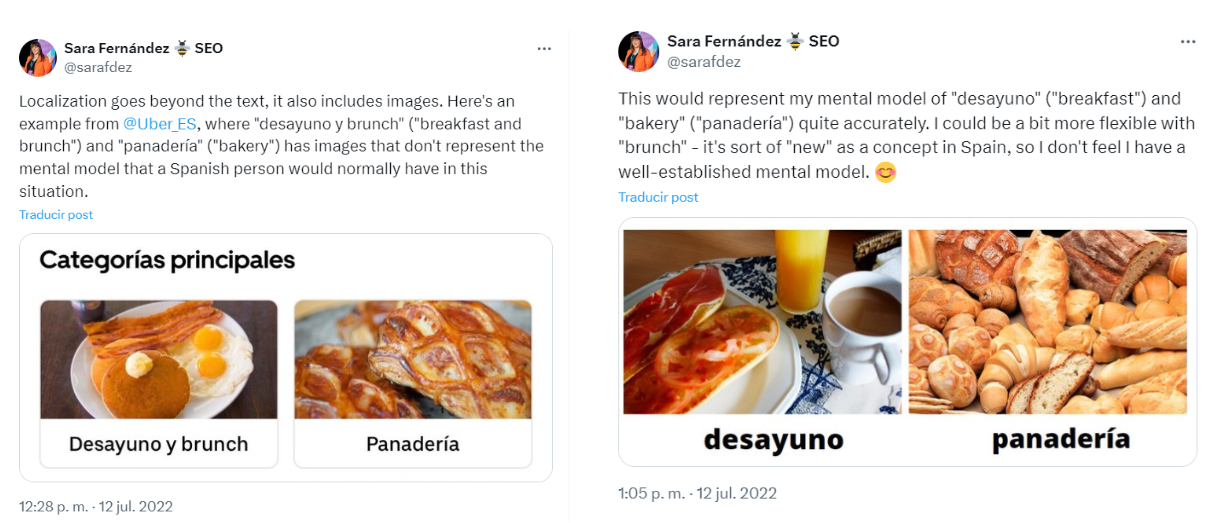
Monitoring and evaluation: KPIs for Localization
As you know, what can't be measured can't be improved. So, which KPIs should we consider when dealing with localization for SEO? Here are a few:
- Website performance: Traffic by country/language, unique page views, time on site, new vs. returning visitors, bounce and conversion rates on localized pages, and average sales comparison.
- Online visibility & engagement: Click-through rates, SEO keyword rankings, and social media engagement specific to target locales.
- Growth & market penetration: New customers, net revenue, average sales per customer, active monthly customers, retention rates, and market share in target locales.
- Customer Experience (CX): Net Promoter Score (NPS), customer satisfaction, support ticket volume by language, and helpability score on localized pages.
Final thoughts
International SEO involves much more than just going through a list of hreflang tags to be implemented. At the heart of successful international expansion lies localization—it emerges not just as a strategy but as a necessary dialogue with the world. It demands from us not only linguistic agility but also cultural empathy. It reminds us that to truly connect with a global audience, we must listen to the subtleties of their language, understand the nuances of their daily lives, and respect the depth of their cultural narratives.
Effective marketing respects cultural boundaries and wholeheartedly embraces global diversity. This journey underscores the critical importance of localizing content with care and precision, tailoring messages to resonate deeply with diverse audiences across the world. By doing so, we not only navigate the complex landscape of cultural nuances but also affirm our commitment to inclusivity and diversity. Localization is foundational to building meaningful connections and ensuring that our strategies reflect the richness and diversity of the global marketplace. I hope that this post is a guide for those entering international SEO, and that it helps promote practices that respect and defend cultural diversity and foster valuable connections.


